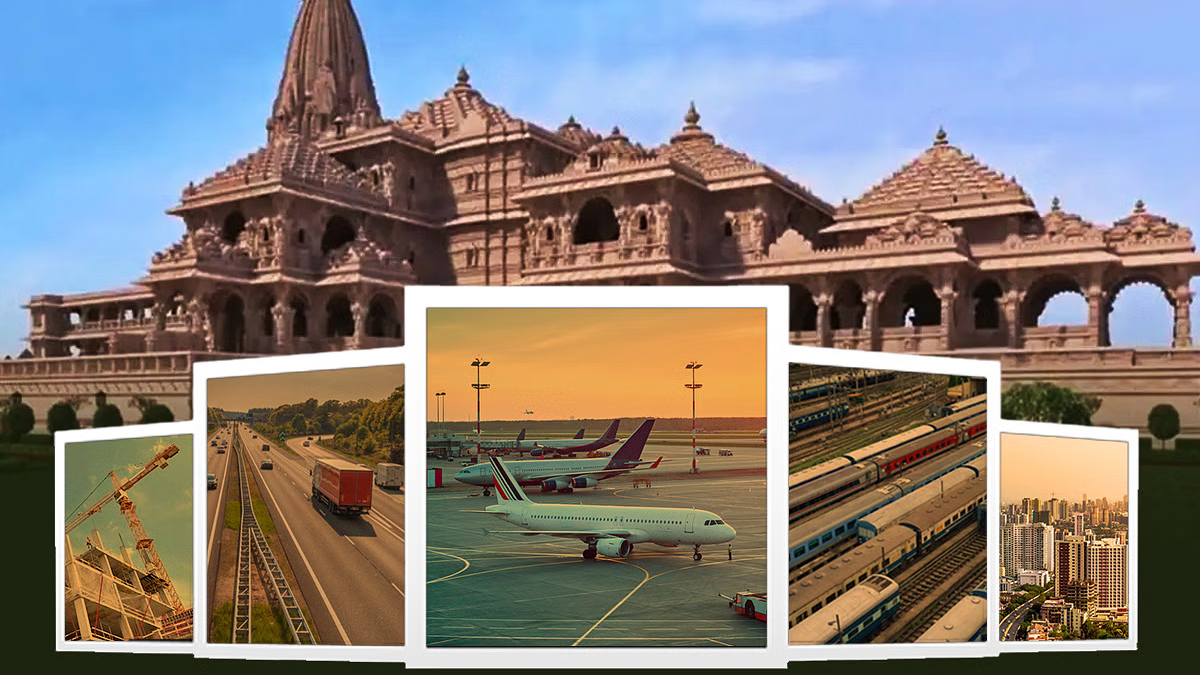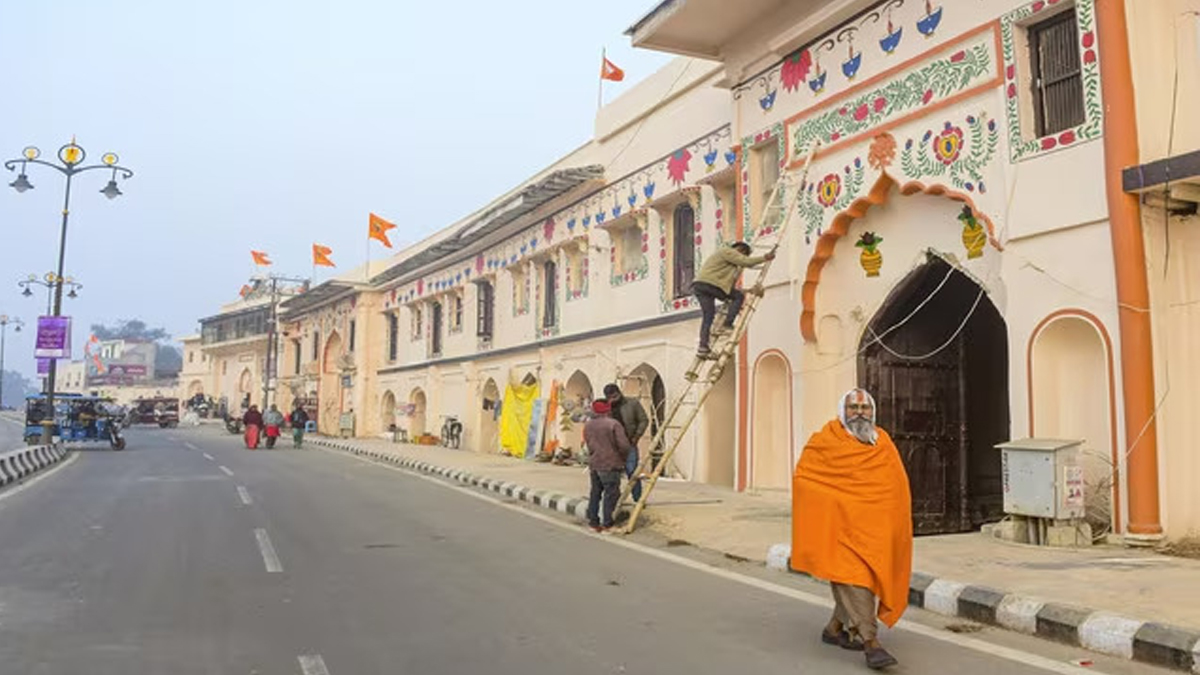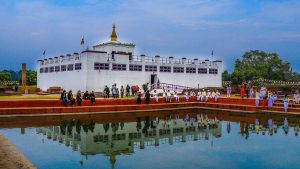
Ayodhya’s Transformation: Ram Mandir’s Impact on Town’s Identity and Development
In the heart of Uttar Pradesh, the ancient town of Ayodhya is undergoing a monumental transformation ahead of the much-anticipated inauguration of the Ram Mandir on January 22. The landscape of the places near the Saryu River, once characterized by narrow lanes and crowded streets, is now a bustling hub of construction and development, symbolizing a shift in the town’s trajectory since the Supreme Court’s landmark verdict in November 2019.
The Ram Path, a 13-kilometer road leading to the under-construction Ram temple, is witnessing a rapid makeover. Cement mixing trucks laden with wet cement traverse the path, while houses and shops along the route undergo a facelift. Building facades are being redone, painted in a uniform shade of cosmic yellow and saffron.
In recent years, Ayodhya’s transformation has encountered obstacles, altering the once tranquil temple town. The serene charm has yielded to an overpowering grandeur that may not universally resonate. The town’s newfound identity has eclipsed its historical tranquillity, with a surge in visitors underscoring its prominence but also raising concerns about overcrowding and strain on local medieval infrastructure. The conflict between Ayodhya’s past simplicity and its current scale prompts reflections on the sustainability and cultural ramifications of this profound shift.
Within the temple town, the constant hum of industrial activity, marked by the rhythmic sounds of hammers and pickaxes, permeates the air. Diligent labourers from Larsen & Toubro (L&T) work tirelessly day and night, crafting intricate pavements, installing shutter gates, and adorning outer facades with meticulous details. Amidst this bustling development, Ayodhya’s economic and social aspects, deeply rooted in its rich heritage, silently suffer setbacks. The prominent Ram Janmbhoomi Site now features walls adorned with vibrant hues, while nearby shops proudly display contemporary Hindutva symbols such as aggressive Ram, Bow and Arrow, and Fierce Hanuman.
Resident Anil Tiwari, an autorickshaw driver, reflects on the unprecedented changes: “I have been living in Ayodhya for the past 40 years, and I have never seen this kind of dramatic change in a city. Until a few months back, the whole city looked like just a pile of rubble.”
The transformation is not limited to the physical appearance of the town. The Ayodhya Master Plan 2031, approved by Chief Minister Yogi Adityanath a year ago, encompasses a comprehensive vision for the town’s development. With a sanctioned budget exceeding ₹30,000 crore, over 200 projects supported by central and state governments are in progress.
The ambitious plan includes a new airport, rejuvenation of the railway station, road-over bridges, multi-level car parks, hotels and townships, road widening, and beautification projects.

With Ram Mandir, a boom in hospitality
As Ayodhya prepares to welcome millions of visitors, the hospitality sector is witnessing a significant boom. Major hotel chains, including Radisson, Wyndham, Marriott, and Indian Hotels Company Ltd (IHCL), have signed deals to open properties in the town.
Accommodations, such as the ‘Tent City’ developed by the Ayodhya Development Authority (ADA) through a public-private partnership, offer a glimpse into the changing landscape of Ayodhya. With tents available for ₹10,000-20,000 a night, the town is gearing up to cater to a diverse range of travellers.
ADA’s homestay scheme, offering accommodation between ₹1,500-2,500 a night, has seen around 600 registrations so far. The town’s hospitality sector is poised for unprecedented growth, reflecting the evolving needs of the increasing number of tourists.
Connectivity at the core
One of the key challenges identified by ADA is improving connectivity. Efforts are underway to address this on multiple fronts – road, rail, and air. The Ayodhya Junction railway station is undergoing expansion, and the Maharishi Valmiki International Airport, spread across 820 acres, is nearing completion.
IndiGo announced its inaugural flight from Delhi to Ayodhya to commence commercial services on January 6. While domestic flights have already been started, international flights are slated to operate by the end of this year. The expansion of major roads connecting Ayodhya to cities like Gorakhpur, Lucknow, Gonda, Varanasi, Raebareli, and Prayagraj is also in progress.
Ayodhya’s strategic location and the influx of pilgrims and tourists are attracting major airline carriers. The airport terminal, marked by a giant entrance gate, signifies the town’s imminent entry into the global aviation map.
The 8 theme-based development
The various developmental and foundational projects have been categorized into eight comprehensive themes – Aesthetic Ayodhya, Clean Ayodhya, Skillful Ayodhya, Convenient Ayodhya, Experiential Ayodhya, Modern Ayodhya, Cultural Ayodhya, and Healthy Ayodhya.
However, in many cases, these themes seem distant. While the upper surface around the Ram Janmabhoomi temple appears both aggressive and developed simultaneously, the inner part of the town reveals a glimpse of the old narrow lanes and surroundings of drains.
This stark contrast between the aggressive and developed exterior near the Ram Janmabhoomi temple and the more traditional, narrow lanes, and drain-filled surroundings within the city raises questions about the holistic implementation of these thematic projects.
It underscores the need for a more nuanced approach, ensuring that the city’s development is not merely superficial but extends to the grassroots level, addressing the historical and cultural intricacies that lie in the heart of Ayodhya. Balancing modernization with the preservation of the city’s heritage becomes crucial for a truly integrated and sustainable transformation.
How to balance the tradition with modernization
As Ayodhya marches towards its new identity as a global spiritual capital, the delicate balance between tradition and modernization becomes crucial. A visit to the city, shows the town’s rich history and heritage risk being overshadowed by commercialization and grandiosity.
The once serene temple town is now a canvas adorned with murals from the Ramayana theme park, selfie points with ‘I LOVE AYODHYA’ boards, and plans for adventure water sports and light shows. However, concerns linger about the impact on Ayodhya’s cultural fabric, with locals expressing worries about the loss of simplicity and tranquillity.
As the world awaits the inauguration of the Ram Mandir on January 22, Ayodhya stands at the crossroads of its ancient past and an exciting, yet uncertain, future.













Comments